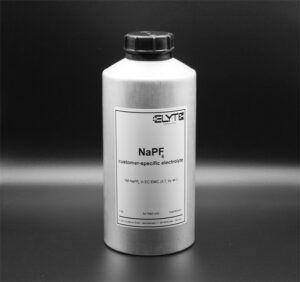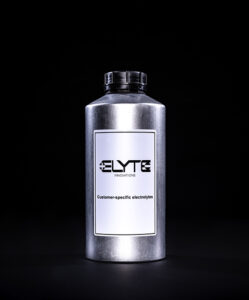
Electrolytes for sodium ion-batteries
Specifications:
| Electrolyte salt | Sodium hexafluorophosphate (NaPF6), sodium bis(trifluoromethanesulfonly)imide (NaTFSI) Plus appropriate co-salts depending on the application. |
| Solvent | Carbonate-based solvents i.e. EC, EMC, PC, DMC, DEC Solvent type and composition is discussable upon application. |
| Example composition |
1 M NaPF6 dissolved in EC:EMC (3:7, w:w) |
| Batch sizes manufactory |
25 mL – 2.0 L bottles |
| Batch sizes production site | 20 L – 200 L barrels |
| Delivery time | maximum 14 days within EU Delivery times outside the EU on request. |
Packaging of our Electrolytes
| 20 L barrel | 200 L barrel | |
|---|---|---|
| Diameter [mm] | <=320 | <=600 |
| Height [mm] | <=530 | <=1150 |
| Net weight [kg] | ~8,5 | ~50 |
| Material (AISI) | 304 / 316L stainless steel | 304 / 316L stainless steel |
| Quick couplings | Nitto Kohki 1P for inert gas Nitto Kohki 2P for product Alternative couplings on request |
Nitto Kohki 2P for inert gas Nitto Kohki 4P for product Alternative couplings on request |
Drums per:
|
7 drums per pallet 12 drums per pallet 12 drums per pallet |
2 drums per pallet 3 drums per pallet 4 drums per pallet |
| Bottle (25 mL – 2.5 L) | Our electrolytes come in UN-certified aluminum bottles (made in Germany), which are wrapped in pouch bags sealed under an inert gas atmosphere. |
| Pouch bags | Shipped in UN-approved cardboard boxes suitable for the transportation of dangerous goods (in compliance with ADR). |
Electrolytes for Sodium-ion batteries (NIBs)
Characteristics
Sodium-ion batteries (NIBs) are attractive alternatives to lithium-ion batteries (LIBs) due to the relative abundance of sodium compared to that of lithium resources. The working principle of a sodium-ion battery is very similar to that of a lithium-ion battery, which is based on shuttling of the ions between the positive and the negative electrode through the electrolyte. Commonly applied negative electrode materials for NIBs are hard of soft carbons, which is mainly due to the thermodynamic instability of Na+ intercalation to graphite. Sodium-containing compounds serve as the positive electrodes, such as Prussian white. Both electrodes use aluminum as the current collector, so aluminum corrosion must be considered while selecting the suitable salt/solvent/additive combination for the electrolyte.
Application fields
The gravimetric energy density of NIBs (70-150 Wh kg-1) is typically lower than that of commercial LIBs (160-260 Wh kg-1), Depending on the used chemistry, Na-ion are suitable to be applied for smaller-scale energy storage applications with an improved safety.
